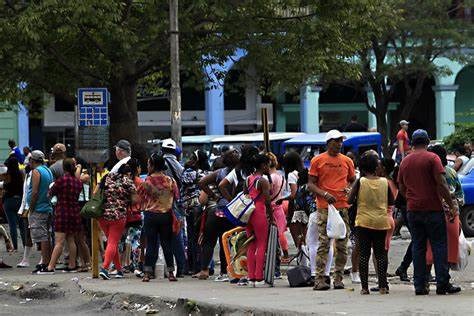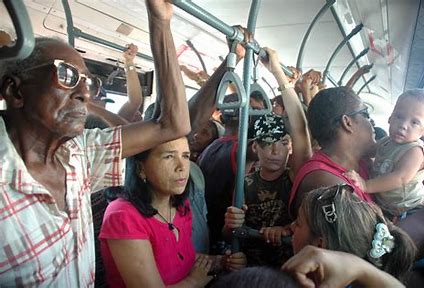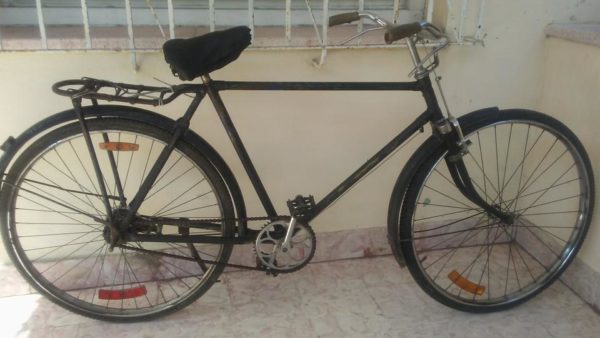What Taking a Bus Means in Today’s Cuba
By Lorenzo Martin
HAVANA TIMES – Like every week, last Sunday I went to visit Mom. Like every Sunday, the journey becomes a real adventure. We definitely need to go back to that healthy means of transportation which is the bicycle, even if it costs me an arm and a leg to buy the tires and tubes for mine.
I left early to try to catch the A8 bus that drops me off quite close and is quite punctual at 8:15 in the morning. I always catch it at the first stop at the tunnel park at the beginning of Cuba Street. I choose this stop, not only because it’s the first one but also because there are several transportation options that take me there: the P5, which, although it takes me farther, is still relatively close, and the gazelles (collective taxis) 22 and 16, which also get me close.
The year definitely didn’t start well for transportation, as for almost anything here. After the announcement of the increase in fuel and transportation prices, the situation has worsened, and the threat is still not executed.

Anyone who hasn’t taken a “guagua” in Cuba has no idea what that is. Taking urban transportation should be considered the national sport, both for the massiveness with which it is practiced and for the physical and psychological demands it places on the athlete, sorry, the passenger. This Sunday was no exception, and I had to showcase my skills to reach my destination. Above all, one must have patience and endurance to stand because the bus wait can last from minutes to two or three hours, as was my case this time. I barely arrived at the stop, and a P5 appeared, but seeing how full it was and considering that the A8 was still on time, I let it pass; it was too early to squeeze into a sardine can.

As my grandmother used to say, the light ahead is the one that shines. The A8 never came, and people kept arriving at the bus stop. I also let an A27 pass, a bus that is not really ideal for me as it leaves me more than two kilometers from my destination, but it’s better than walking. Only two gazelles passed, and they didn’t pick up or stop, so I waited until nine, then ten, and ended up sitting under a tree, resigned that the A8 wouldn’t come, and I would have to take whatever came my way or walk or give up the trip.

Finally, an A27 arrived again, and I decided to board it, another modality demanded by the pentathlon that is taking urban transportation in Havana: you have to know how to push, withstand pushes, sneak through a needle’s eye, and most importantly, do it without losing your wallet or phone in the process. Almost at 11 in the morning, I managed to board, and inside, I found all the fauna that one can find on a Cuban “guagua.”
When you get on the crowded ring that is the “guagua,” you are greeted by a fare collector who does his best to keep the change and does nothing but repeat: “Gentlemen, walk a little, there’s space in the aisle, stand to the side,” even though there’s no room for a straw between passengers.
Besides, the “guagua” being as packed as a can of compressed sardines, there was a guy with a half-filled sack blocking the aisle. There was no shortage of a group of teenagers at the back of the bus, emulating the volume of reggaeton coming from the driver’s powerful sound system. Teenagers who didn’t hesitate to use the most vulgar phrases imaginable.

The trip lasted almost an hour, where I could see and hear the well-built girl causing a scandal to the passenger behind her for “leaning on her.” There was also a guy who got off and realized his cellphone had been stolen, and he started shouting obscenities from below while trying in vain to get back on. There was the one pretending to be asleep, looking out the window, or locking himself in his phone with headphones on to avoid giving up his seat to an elderly person or a pregnant woman or someone with children in their arms.
Conversations ranged from how bad “this” is, the difficulty of transportation, the meager rations from the store, the threatening measures the government is taking and some personal or family themes where you found out that so-and-so has been cheating on so-and-so.
Finally, I got off at the Acapulco cinema stop, not without making the greatest effort, pushing left and right to reach the door and get off. After such an adventure, walking the remaining stretch, crossing the Almendares bridge, and heading towards Mom’s house seemed like a panacea.

This is becoming too much like the infamous “Special Period” crisis of the ‘90’s and all that’s left is to withdraw all transportation and return to the mythical “camello” (a truck with a structure adapted for passenger transport that carried more than a hundred persons), which I really don’t feel fit to use at this stage of life. Yes, I’ll have to reactivate my old bike…
Read more from the diary of Lorenzo Martin here on Havana Times.






On my last trip to La Habana last year, I rode collectivos every day from my casa particular to the gym and paid the same price as Cubans without issue. I am an African American so maybe I was assumed to be Cuban but my yuma accent when I speak Spanish is a dead giveaway that I am not Cuban. Anyway, the one time ( and last time) I took a double length guagua from San Miguel Padron to Central Havana, I was amused by the entire conversation around me that my presence provoked. People all around me, once I began speaking, began to question why the hell would I be taking the bus! I think it was either the P11 or P5 but it was stifling hot and super crowded. These Cubans simply couldn’t understand why someone with the means to take a taxi would subject themselves to this torture. I finally responded that I had waited 30 minutes for a taxi and so when the bus showed up, I said why not. It was funny and sad how the folks around me imagined how different their lives could be if they had the resources of a tourist.
Theo – your last sentence surprised me. When were these fines introduced? We were in Cuba in May of 2019, and took a collectivo from city to city. These were big station wagons converted to hold 3 bench seats. They were definitely classic cars, usually Chevrolets. We also hired a beautiful red convertible for a tour around La Habana; this was undoubtedly a classic car. We are planning a visit from Mexico, in support of the Cuban people. Has Cuba changed that much for the worse?
Brutal first hand story. Sounds like I was there.
I haven’t taken a guagua, but I did take those blue machina a few times , buying out the whole thing in order to transport a bike and luggage. Also sat in the other type of shared vans , forget their name. Always getting charged Yuma prices , doing my best to minimize the costs but still cheaper than taxis.
The classic cars get a fine if they are caught by police transporting a Yuma!